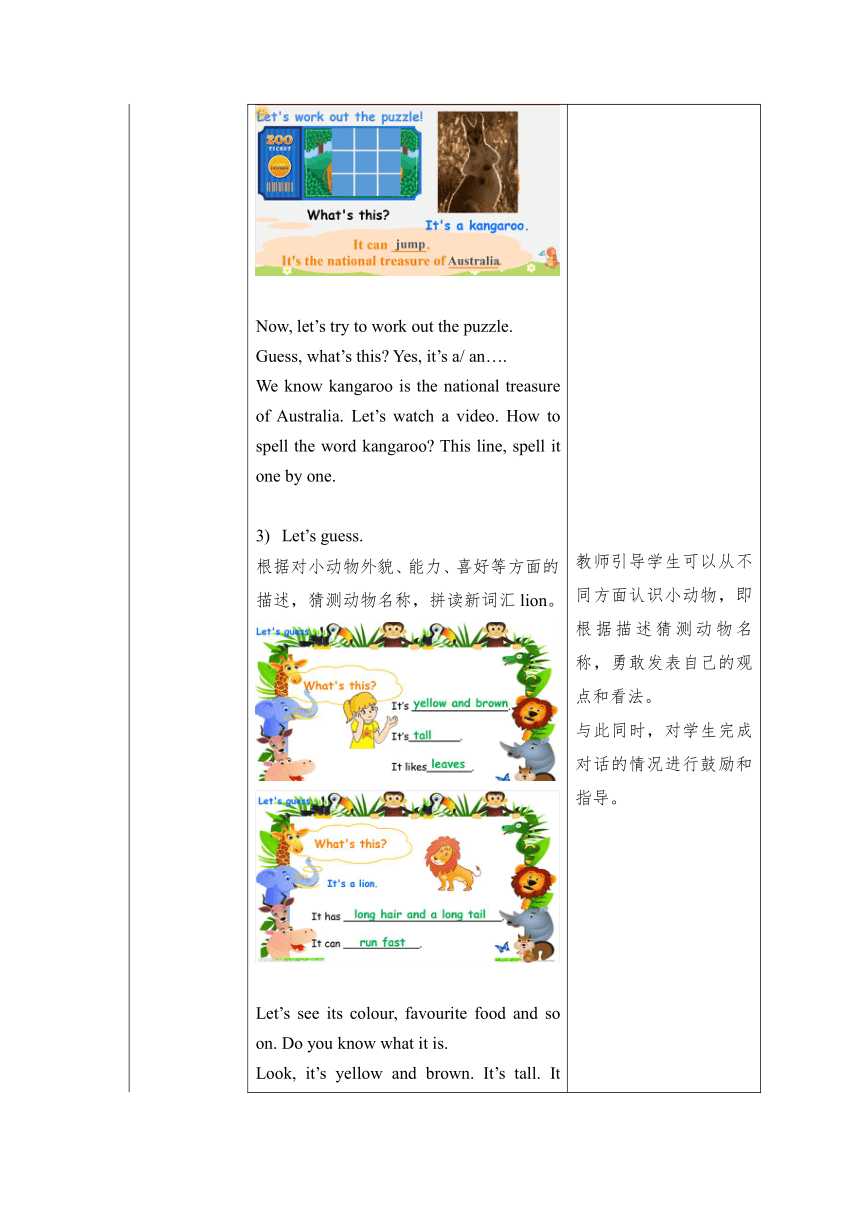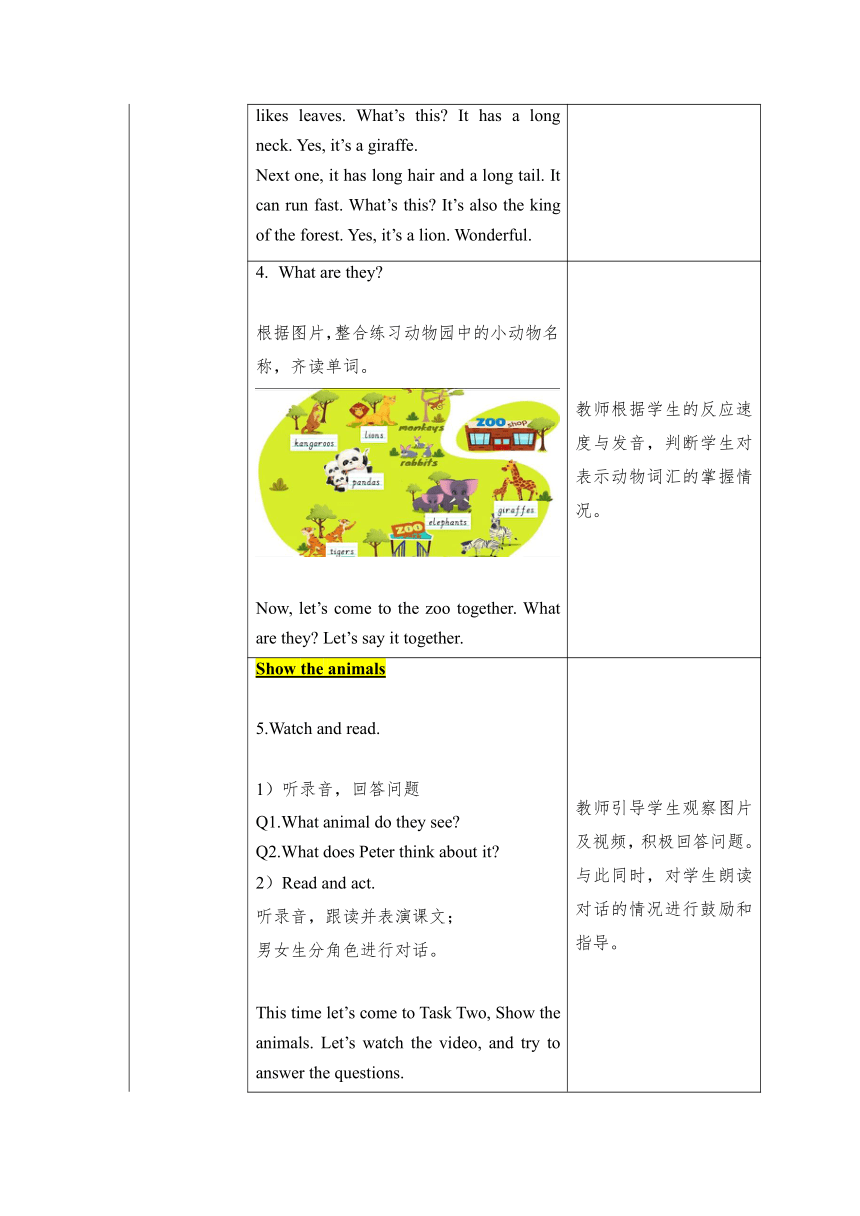nit 5 It's a parrot. Lesson 25 表格式教学设计
文档属性
| 名称 | nit 5 It's a parrot. Lesson 25 表格式教学设计 |

|
|
| 格式 | docx | ||
| 文件大小 | 3.4MB | ||
| 资源类型 | 教案 | ||
| 版本资源 | 人教精通版(三年级起点) | ||
| 科目 | 英语 | ||
| 更新时间 | 2024-06-02 21:21:35 | ||
图片预览





文档简介
Unit 5 Lesson25教学设计
【课时对应的子主题】 认识动物特征、保护关爱动物
【适用年级】三年级
【语篇类型】日常对话
【语篇研读】
What: 本课时所学语篇为小学生情景对话,话题为动物,对话内容围绕Peter与妈妈去动物园观看动物,询问其是什么的场景展开。
Why:作者通过描述Peter与妈妈去动物园观看狮子的场景,加深学生对各类动物特性以及如何询问近处动物或物品是什么的理解,并引导学生在日常生活中保护关爱小动物。
How: 本课是典型的日常生活对话,涉及有关动物的词汇,如kangaroo, lion以及向他人询问近处是什么动物的核心语言What’s this It’s a/ an….对话内容与学生实际生活紧密相连,简单易懂,且具有一定的教育意义。
【课时目标】
1. 在看、听、说的活动中感知获取如何询问同伴近处的小动物是什么(What’s this )并进行回答(It’s a/ an….)。结合图片,能够听、说、认读kangaroo和lion两种小动物。
2. 在教师指导下,进行角色扮演与新对话创编;并在不同情境下,运用核心语言与同伴谈论近处的小动物是什么。
3. 通过组内制作动物名片、讨论小动物居住地等活动,了解小动物们的习性特点,进而强化保护和爱护小动物的意识。
【重难点】
在看、听、说的活动中感知获取如何询问同伴近处的小动物是什么(What’s this )并进行回答(It’s a/ an….)。结合图片,能够听、说、认读kangaroo和lion两种小动物。
【教学过程】
教学目标 学习活动 效果评价
1. 在看、听、说的活动中感知获取如何询问同伴近处的小动物是什么(What’s this )并进行回答(It’s a/ an….)。结合图片,能够听、说、认读kangaroo和lion两种小动物。(学习理解) 1.Warm-up. Let’s listen. 倾听并演唱英文歌曲,提取歌词中表示动物的词汇。 First, let’s sing a song together. Boys and girls, a question for you. What animals can you hear And where are we going Pretty good, let’s go to the zoo. 教师观察学生的活动参与情况,鼓励学生勇敢说出视频中出现的动物名称,并进行反馈。
2.在情境中,明确本节课教学目标。 为了帮助Grandpa成为一名优秀的zoo keeper,明确本节课需要完成Know the animals; Show the animals; Make animal cards; Live with animals四项任务。 Look, this is grandpa. He wants to be a zoo keeper. Can you help him You are really helpful. Today, we have to Know the animals; Show the animals; Make animal cards; Live with animals. Are you ready Let’s go. 教师观察学生是否被所创设情境吸引,是否了解本节课目标,并唤醒学生对动物话题知识的已知。
Know the animals 3.What’s this 依据动物声音、拼图游戏、语言描述等媒介猜测动物名称。 Listen and guess. 根据动物所发出的声音,尝试用目标语言回答动物名称。 ——What’s this ——It’s a tiger. ——What’s this ——It’s an elephant. Now, let’s listen and guess what’s this. Let’s work out the puzzle. 借助拼图碎片猜测动物,巩固对话内容; 与此同时,认识拼读新词汇kangaroo; 并通过关键词填空,强化对所呈现小动物特性的认识理解。 Now, let’s try to work out the puzzle. Guess, what’s this Yes, it’s a/ an…. We know kangaroo is the national treasure of Australia. Let’s watch a video. How to spell the word kangaroo This line, spell it one by one. Let’s guess. 根据对小动物外貌、能力、喜好等方面的描述,猜测动物名称,拼读新词汇lion。 Let’s see its colour, favourite food and so on. Do you know what it is. Look, it’s yellow and brown. It’s tall. It likes leaves. What’s this It has a long neck. Yes, it’s a giraffe. Next one, it has long hair and a long tail. It can run fast. What’s this It’s also the king of the forest. Yes, it’s a lion. Wonderful. 教师引导学生认真聆听小动物们的声音,并积极猜测动物名称。与此同时,对学生的对话情况进行鼓励和指导。 教师观察学生参与情况,鼓励并引导学生积极表现自己。 教师根据学生拼读、朗读词汇情况及时予以反馈,提供鼓励与帮助。 教师引导学生可以从不同方面认识小动物,即根据描述猜测动物名称,勇敢发表自己的观点和看法。 与此同时,对学生完成对话的情况进行鼓励和指导。
What are they 根据图片,整合练习动物园中的小动物名称,齐读单词。 Now, let’s come to the zoo together. What are they Let’s say it together. 教师根据学生的反应速度与发音,判断学生对表示动物词汇的掌握情况。
Show the animals 5.Watch and read. 1)听录音,回答问题 Q1.What animal do they see Q2.What does Peter think about it 2)Read and act. 听录音,跟读并表演课文; 男女生分角色进行对话。 This time let’s come to Task Two, Show the animals. Let’s watch the video, and try to answer the questions. Now let’s read and act. Boys first, and then girls. And this time, girls first. One, two go. 教师引导学生观察图片及视频,积极回答问题。与此同时,对学生朗读对话的情况进行鼓励和指导。
设计意图:本阶段学习活动旨在呈现如何向他人询问近处的动物是什么。学生在教师所创设情境(how to be a good zoo keeper)中感知What’s this It’s…的用法。在词汇学习的过程中,教师引导学生发展拼读能力,积累有关动物方面的词汇,并对如何描述动物特征形成理解认识。此外,学生通过回答问题与朗读对话,进一步理解语言点,内化语言。
2. 在教师指导下,进行角色扮演与新对话创编;并在不同情境下,运用核心语言与同伴谈论近处的小动物是什么。(应用实践) 6.Make a new dialogue. 基于对话框架与图片,两人一组完成对话。 All of you did a good job. We can see so many animals in the zoo. What are they Now, two in a group, and try to make a new dialogue with your partner. 教师帮助引导学生归纳对话中的核心语言点,并观察学生在语境中能否灵活运用语言点进行沟通交流,并根据学生的表现及时进行反馈。
7. Sell the souvenirs. 根据小动物的影子,运用所学对话询问并猜测动物名称;与此同时,借助涂蒙层揭晓答案。 ——What’s this ——It’s an elephant. There are also so many souvenirs in the zoo, but they are not clear. Can you help Grandpa Let’s look the shadows, and talk about what are they. We can use the sentences here. 依据图片,引导学生基于框架进行对话。 在此过程中,对学生的发音及时进行纠正,并对学生的表现及时进行反馈鼓励。
设计意图:本阶段学习活动旨在引导学生归纳并巩固如何询问近处动物、物品是什么。通过丰富多彩的角色体验,引导学生运用语言理解意义;且为学生进一步展现自己描述动物特征,意识到在日常生活中要爱护照顾动物做铺垫。
3. 通过组内制作动物名片、讨论小动物居住地等活动,了解小动物们的习性特点,进而强化保护和爱护小动物的意识。(迁移创新) Make animal cards 8.Make animals cards. 根据所给样例,认识理解我们可以从外貌、能力、习惯喜好等方面介绍小动物。经小组讨论,借助图片与word bank中的信息介绍各组动物的名片。 Look, what’s this Yes, it’s a panda. What’s panda like What colour is it Is it fat Is it cute We can say it’s black and white. It’s cute. It’s about the appearance of the panda. What can panda do Maybe it can climb trees. It’s about the ability of the panda. What does panda like Very good. It likes bamboo. It’s about the habit of the panda. And it’s also the national treasure of China. Now, it’s your time. Try to finish your our animal cards with your partners in your group. 教师通过问题,引导学生思考可以从哪些方面介绍认识小动物。 教师观察小组讨论情况;在组内,不断启发学生,引导其产出目标语言。 与此同时,鼓励学生积极表现自己,并根据学生的表现及时进行反馈。
Live with animals 9.Let’s think and write. 学生思考小动物们应该生活在哪里; 结合实际生活,小组内进行讨论并写下Live at home; Live in the zoo; Live in nature的小动物。 Boys and girls, a question for you. Do you think animals should live at home, live in the zoo or live in nature Now try to write down the name of the animals in the table, and I will invite some groups share your answers then. Three, two, one go. 教师向学生呈现例子,引发学生对小动物们应该在哪里生活进行思考。 教师观察学生小组讨论参与情况,鼓励并引导学生积极表现自己。 学生发言时,教师对其发音及时进行纠正,并对其表现及时进行反馈鼓励。
10.Let’s read together. 阅读藏头诗,强化保护动物、爱护动物的意识。 In the end, let’s read the poem together. What’s the first letter of each sentence Wonderful, animals. So boys and girls, in our daily life, we should love animals and protect animals. Do you agree with me 教师和学生共同阅读,升华情感,并感受保护动物,爱护动物的意义。
11.Evaluation 通过帮助Grandpa完成了各项任务,每位同学都成为了优秀的zoo keeper. Today, we talk about animals in the zoo. We also help Grandpa to be a zoo keeper. We all good zoo keepers. Congratulations. 教师引导学生对本节课所学内容进行回顾总结,并进行自评,找出自身不足,努力提升。
设计意图: 本阶段学习活动旨在帮助学生梳理描述动物特性,并强化在现实生活中要爱护保护动物的意识。通过拓展学习,教师引导学生发散思维,补充小动物们的外貌特征、能力优势、生活习性等,进一步实现多维度描述,促进语言的实践与应用;思考小动物们的居住地,能够有效调动学生的已知,并培养其批判性思维能力;藏头诗的总结与升华发展了孩子们爱护照顾动物的好习惯。除此之外,丰富的小组讨论与活动也进一步加强了学生们的创新精神与合作能力。
【板书设计】
【作业设计】
【课时对应的子主题】 认识动物特征、保护关爱动物
【适用年级】三年级
【语篇类型】日常对话
【语篇研读】
What: 本课时所学语篇为小学生情景对话,话题为动物,对话内容围绕Peter与妈妈去动物园观看动物,询问其是什么的场景展开。
Why:作者通过描述Peter与妈妈去动物园观看狮子的场景,加深学生对各类动物特性以及如何询问近处动物或物品是什么的理解,并引导学生在日常生活中保护关爱小动物。
How: 本课是典型的日常生活对话,涉及有关动物的词汇,如kangaroo, lion以及向他人询问近处是什么动物的核心语言What’s this It’s a/ an….对话内容与学生实际生活紧密相连,简单易懂,且具有一定的教育意义。
【课时目标】
1. 在看、听、说的活动中感知获取如何询问同伴近处的小动物是什么(What’s this )并进行回答(It’s a/ an….)。结合图片,能够听、说、认读kangaroo和lion两种小动物。
2. 在教师指导下,进行角色扮演与新对话创编;并在不同情境下,运用核心语言与同伴谈论近处的小动物是什么。
3. 通过组内制作动物名片、讨论小动物居住地等活动,了解小动物们的习性特点,进而强化保护和爱护小动物的意识。
【重难点】
在看、听、说的活动中感知获取如何询问同伴近处的小动物是什么(What’s this )并进行回答(It’s a/ an….)。结合图片,能够听、说、认读kangaroo和lion两种小动物。
【教学过程】
教学目标 学习活动 效果评价
1. 在看、听、说的活动中感知获取如何询问同伴近处的小动物是什么(What’s this )并进行回答(It’s a/ an….)。结合图片,能够听、说、认读kangaroo和lion两种小动物。(学习理解) 1.Warm-up. Let’s listen. 倾听并演唱英文歌曲,提取歌词中表示动物的词汇。 First, let’s sing a song together. Boys and girls, a question for you. What animals can you hear And where are we going Pretty good, let’s go to the zoo. 教师观察学生的活动参与情况,鼓励学生勇敢说出视频中出现的动物名称,并进行反馈。
2.在情境中,明确本节课教学目标。 为了帮助Grandpa成为一名优秀的zoo keeper,明确本节课需要完成Know the animals; Show the animals; Make animal cards; Live with animals四项任务。 Look, this is grandpa. He wants to be a zoo keeper. Can you help him You are really helpful. Today, we have to Know the animals; Show the animals; Make animal cards; Live with animals. Are you ready Let’s go. 教师观察学生是否被所创设情境吸引,是否了解本节课目标,并唤醒学生对动物话题知识的已知。
Know the animals 3.What’s this 依据动物声音、拼图游戏、语言描述等媒介猜测动物名称。 Listen and guess. 根据动物所发出的声音,尝试用目标语言回答动物名称。 ——What’s this ——It’s a tiger. ——What’s this ——It’s an elephant. Now, let’s listen and guess what’s this. Let’s work out the puzzle. 借助拼图碎片猜测动物,巩固对话内容; 与此同时,认识拼读新词汇kangaroo; 并通过关键词填空,强化对所呈现小动物特性的认识理解。 Now, let’s try to work out the puzzle. Guess, what’s this Yes, it’s a/ an…. We know kangaroo is the national treasure of Australia. Let’s watch a video. How to spell the word kangaroo This line, spell it one by one. Let’s guess. 根据对小动物外貌、能力、喜好等方面的描述,猜测动物名称,拼读新词汇lion。 Let’s see its colour, favourite food and so on. Do you know what it is. Look, it’s yellow and brown. It’s tall. It likes leaves. What’s this It has a long neck. Yes, it’s a giraffe. Next one, it has long hair and a long tail. It can run fast. What’s this It’s also the king of the forest. Yes, it’s a lion. Wonderful. 教师引导学生认真聆听小动物们的声音,并积极猜测动物名称。与此同时,对学生的对话情况进行鼓励和指导。 教师观察学生参与情况,鼓励并引导学生积极表现自己。 教师根据学生拼读、朗读词汇情况及时予以反馈,提供鼓励与帮助。 教师引导学生可以从不同方面认识小动物,即根据描述猜测动物名称,勇敢发表自己的观点和看法。 与此同时,对学生完成对话的情况进行鼓励和指导。
What are they 根据图片,整合练习动物园中的小动物名称,齐读单词。 Now, let’s come to the zoo together. What are they Let’s say it together. 教师根据学生的反应速度与发音,判断学生对表示动物词汇的掌握情况。
Show the animals 5.Watch and read. 1)听录音,回答问题 Q1.What animal do they see Q2.What does Peter think about it 2)Read and act. 听录音,跟读并表演课文; 男女生分角色进行对话。 This time let’s come to Task Two, Show the animals. Let’s watch the video, and try to answer the questions. Now let’s read and act. Boys first, and then girls. And this time, girls first. One, two go. 教师引导学生观察图片及视频,积极回答问题。与此同时,对学生朗读对话的情况进行鼓励和指导。
设计意图:本阶段学习活动旨在呈现如何向他人询问近处的动物是什么。学生在教师所创设情境(how to be a good zoo keeper)中感知What’s this It’s…的用法。在词汇学习的过程中,教师引导学生发展拼读能力,积累有关动物方面的词汇,并对如何描述动物特征形成理解认识。此外,学生通过回答问题与朗读对话,进一步理解语言点,内化语言。
2. 在教师指导下,进行角色扮演与新对话创编;并在不同情境下,运用核心语言与同伴谈论近处的小动物是什么。(应用实践) 6.Make a new dialogue. 基于对话框架与图片,两人一组完成对话。 All of you did a good job. We can see so many animals in the zoo. What are they Now, two in a group, and try to make a new dialogue with your partner. 教师帮助引导学生归纳对话中的核心语言点,并观察学生在语境中能否灵活运用语言点进行沟通交流,并根据学生的表现及时进行反馈。
7. Sell the souvenirs. 根据小动物的影子,运用所学对话询问并猜测动物名称;与此同时,借助涂蒙层揭晓答案。 ——What’s this ——It’s an elephant. There are also so many souvenirs in the zoo, but they are not clear. Can you help Grandpa Let’s look the shadows, and talk about what are they. We can use the sentences here. 依据图片,引导学生基于框架进行对话。 在此过程中,对学生的发音及时进行纠正,并对学生的表现及时进行反馈鼓励。
设计意图:本阶段学习活动旨在引导学生归纳并巩固如何询问近处动物、物品是什么。通过丰富多彩的角色体验,引导学生运用语言理解意义;且为学生进一步展现自己描述动物特征,意识到在日常生活中要爱护照顾动物做铺垫。
3. 通过组内制作动物名片、讨论小动物居住地等活动,了解小动物们的习性特点,进而强化保护和爱护小动物的意识。(迁移创新) Make animal cards 8.Make animals cards. 根据所给样例,认识理解我们可以从外貌、能力、习惯喜好等方面介绍小动物。经小组讨论,借助图片与word bank中的信息介绍各组动物的名片。 Look, what’s this Yes, it’s a panda. What’s panda like What colour is it Is it fat Is it cute We can say it’s black and white. It’s cute. It’s about the appearance of the panda. What can panda do Maybe it can climb trees. It’s about the ability of the panda. What does panda like Very good. It likes bamboo. It’s about the habit of the panda. And it’s also the national treasure of China. Now, it’s your time. Try to finish your our animal cards with your partners in your group. 教师通过问题,引导学生思考可以从哪些方面介绍认识小动物。 教师观察小组讨论情况;在组内,不断启发学生,引导其产出目标语言。 与此同时,鼓励学生积极表现自己,并根据学生的表现及时进行反馈。
Live with animals 9.Let’s think and write. 学生思考小动物们应该生活在哪里; 结合实际生活,小组内进行讨论并写下Live at home; Live in the zoo; Live in nature的小动物。 Boys and girls, a question for you. Do you think animals should live at home, live in the zoo or live in nature Now try to write down the name of the animals in the table, and I will invite some groups share your answers then. Three, two, one go. 教师向学生呈现例子,引发学生对小动物们应该在哪里生活进行思考。 教师观察学生小组讨论参与情况,鼓励并引导学生积极表现自己。 学生发言时,教师对其发音及时进行纠正,并对其表现及时进行反馈鼓励。
10.Let’s read together. 阅读藏头诗,强化保护动物、爱护动物的意识。 In the end, let’s read the poem together. What’s the first letter of each sentence Wonderful, animals. So boys and girls, in our daily life, we should love animals and protect animals. Do you agree with me 教师和学生共同阅读,升华情感,并感受保护动物,爱护动物的意义。
11.Evaluation 通过帮助Grandpa完成了各项任务,每位同学都成为了优秀的zoo keeper. Today, we talk about animals in the zoo. We also help Grandpa to be a zoo keeper. We all good zoo keepers. Congratulations. 教师引导学生对本节课所学内容进行回顾总结,并进行自评,找出自身不足,努力提升。
设计意图: 本阶段学习活动旨在帮助学生梳理描述动物特性,并强化在现实生活中要爱护保护动物的意识。通过拓展学习,教师引导学生发散思维,补充小动物们的外貌特征、能力优势、生活习性等,进一步实现多维度描述,促进语言的实践与应用;思考小动物们的居住地,能够有效调动学生的已知,并培养其批判性思维能力;藏头诗的总结与升华发展了孩子们爱护照顾动物的好习惯。除此之外,丰富的小组讨论与活动也进一步加强了学生们的创新精神与合作能力。
【板书设计】
【作业设计】
同课章节目录
- Unit 1 Let's go to school.
- Lesson 1
- Lesson 2
- Lesson 3
- Lesson 4
- Lesson 5
- Lesson 6 Revision
- Unit 2 I'm in Class One, Grade Three.
- Lesson 7
- Lesson 8
- Lesson 9
- Lesson 10
- Lesson 11
- Lesson 12 Revision
- Unit 3 This is my father.
- Lesson 13
- Lesson 14
- Lesson 15
- Lesson 16
- Lesson 17
- Lesson 18 Revision
- Fun Time 1
- Recycle 1
- Recycle 2
- Project
- Unit 4 Do you like candy?
- Lesson 19
- Lesson 20
- Lesson 21
- Lesson 22
- Lesson 23
- Lesson 24 Revision
- Unit 5 It's a parrot.
- Lesson 25
- Lesson 26
- Lesson 27
- Lesson 28
- Lesson 29
- Lesson 30 Revision
- Unit 6 Is this your skirt?
- Lesson 31
- Lesson 32
- Lesson 33
- Lesson 34
- Lesson 35
- Lesson 36 Revision
- Fun Time 2
- Recycle 1
- Recycle 2
- Project
